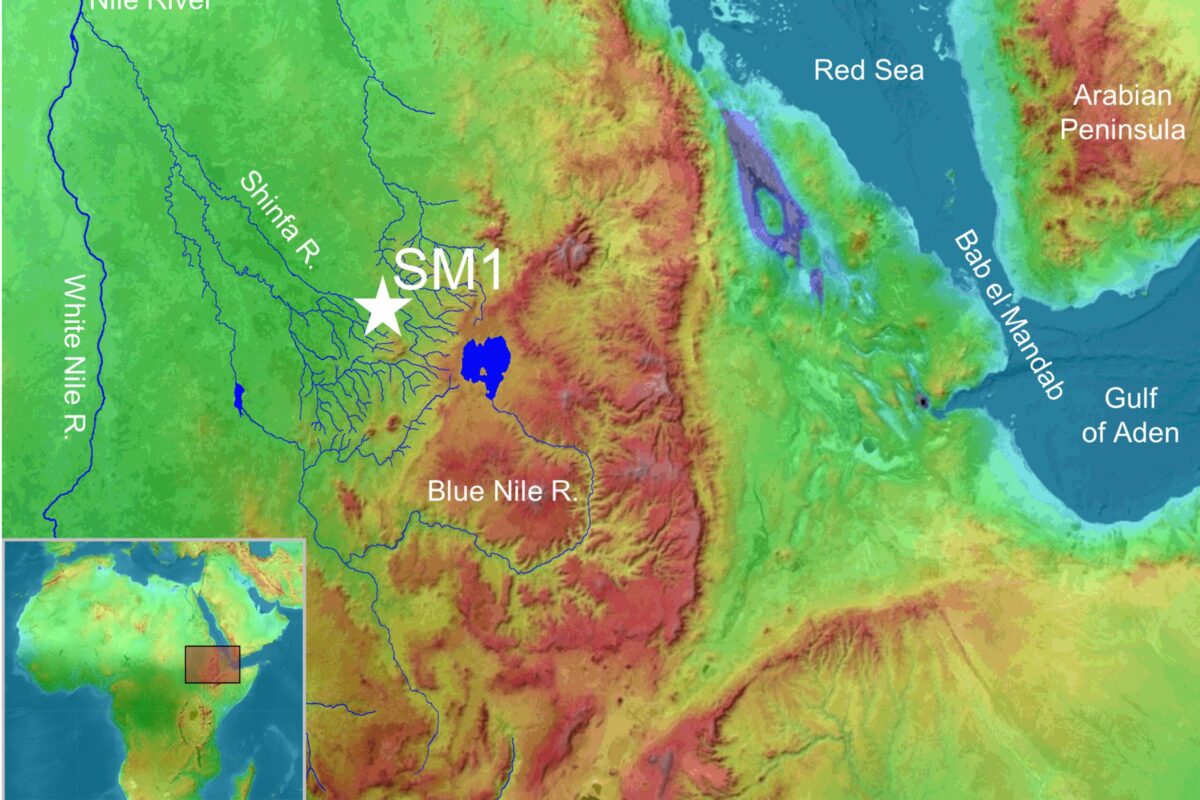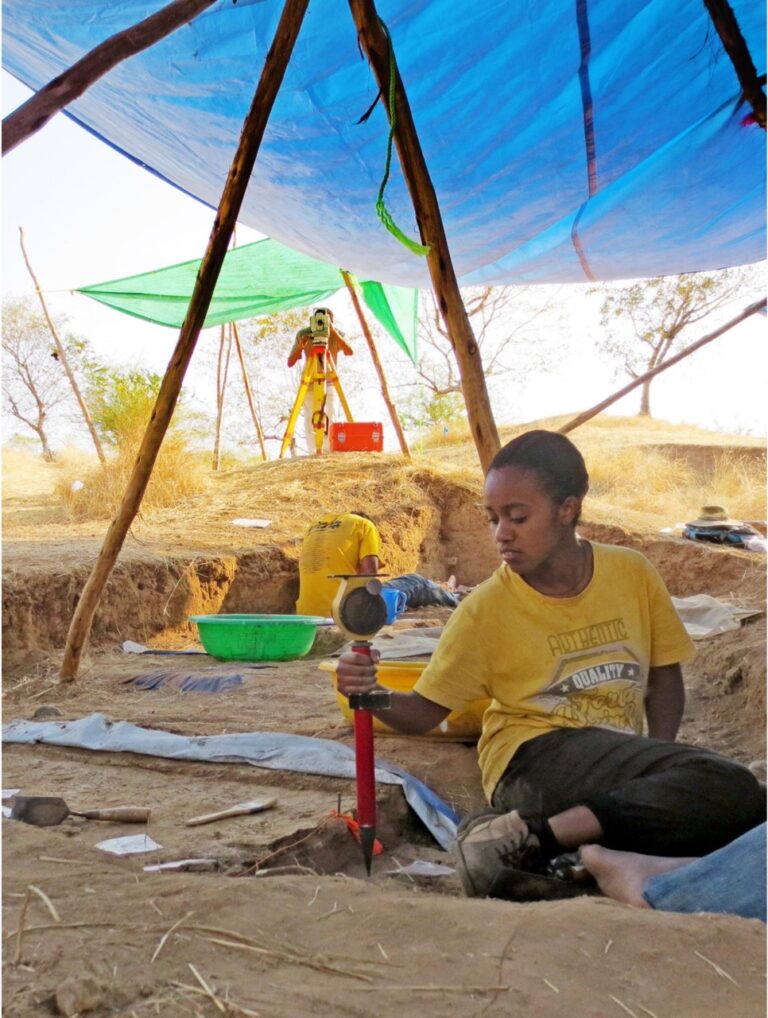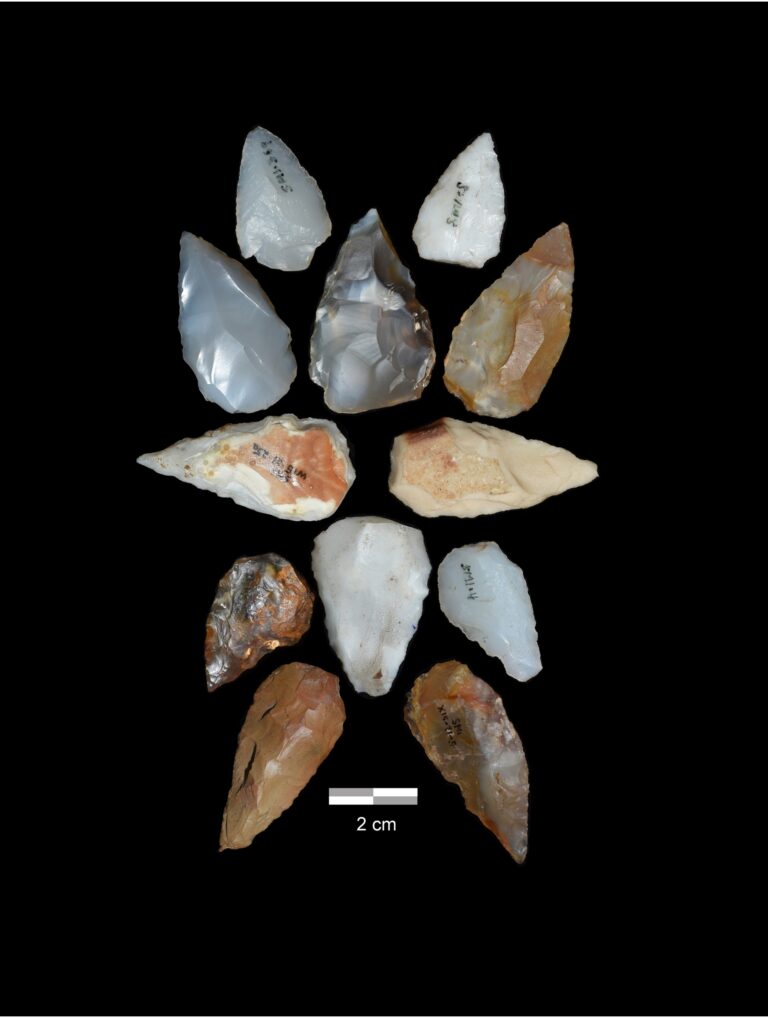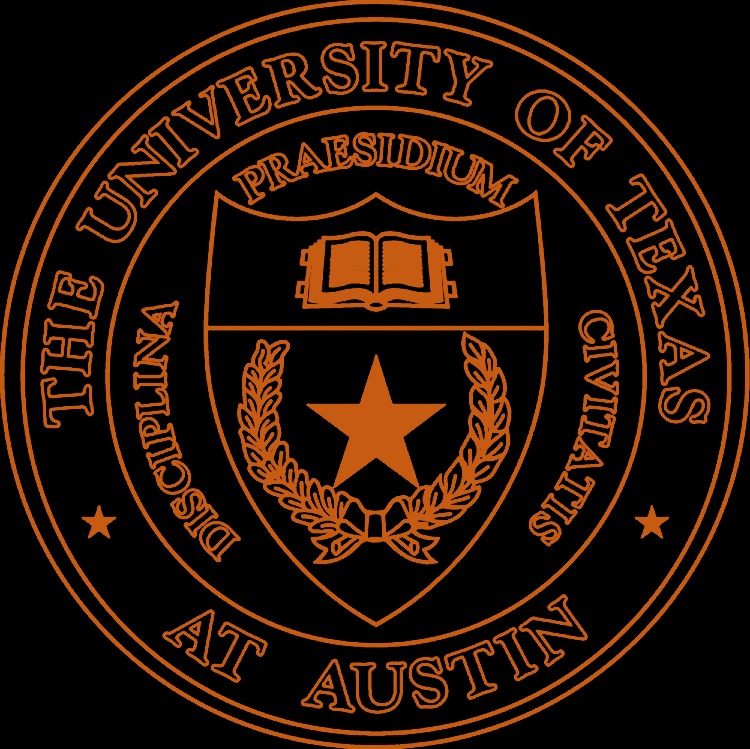From The University of Texas-Austin
3.20.24
Media Contact
Alex Reshanov
College of Liberal Arts
areshanov@austin.utexas.edu

Researchers working in the Horn of Africa have uncovered evidence showing how Middle Stone Age humans survived in the wake of the eruption of Toba, one of the largest supervolcanoes in history, some 74,000 years ago. The behavioral flexibility of these Middle Stone Age people not only helped them live through the supereruption but may have facilitated the later dispersal of modern humans out of Africa and across the rest of the world.
Modern humans dispersed from Africa multiple times, but the event that led to global expansion occurred less than 100,000 years ago. Some researchers hypothesize that dispersals were restricted to “green corridors” formed during humid intervals when food was abundant and human populations expanded in lockstep with their environments. But a new study in Nature led by scientists at The University of Texas at Austin suggests that humans also may have dispersed during arid intervals along “blue highways” created by seasonal rivers. Researchers also found stone tools that represent the oldest evidence of archery.

Excavations at a Middle Stone Age archaeological site, Shinfa-Metema 1, in the lowlands of northwest Ethiopia revealed a population of humans at 74,000 years ago that survived the eruption of the Toba supervolcano.
The team investigated the Shinfa-Metema 1 site in the lowlands of present-day northwestern Ethiopia along the Shinfa River, a tributary of the Blue Nile River. Based on isotope geochemistry of the teeth of fossil mammals and ostrich eggshells, they concluded that the site was occupied by humans during a time with long dry seasons on par with some of the most seasonally arid habitats in East Africa today. Additional findings suggest that when river flows stopped during dry periods, people adapted by hunting animals that came to the remaining waterholes to drink. As waterholes continued to shrink, it became easier to capture fish without any special equipment, and diets shifted more heavily to fish.
The supereruption occurred during the middle of the time when the site was occupied and is documented by tiny glass shards whose chemistry matches that of Toba. Its climatic effects appear to have produced a longer dry season, causing people in the area to rely even more on fish. The shrinking of the waterholes may also have pushed humans to migrate outward in search of more food.
“As people depleted food in and around a given dry season waterhole, they were likely forced to move to new waterholes,” said John Kappelman, a UT anthropology and earth and planetary sciences professor and lead author of the study. “Seasonal rivers thus functioned as ‘pumps’ that siphoned populations out along the channels from one waterhole to another, potentially driving the most recent out-of-Africa dispersal.”
The humans who lived at Shinfa-Metema 1 are unlikely to have been members of the group that left Africa. However, the behavioral flexibility that helped them adapt to challenging climatic conditions such as the Toba supereruption was probably a key trait of Middle Stone Age humans that allowed our species to ultimately disperse from Africa and expand across the globe.
The people living in the Shinfa-Metema 1 site hunted a variety of terrestrial animals, from antelope to monkey, as attested to by cut marks on the bones, and apparently cooked their meals as shown by evidence of controlled fire at the site. The most distinctive stone tools are small, symmetrical triangular points.

Projectile points from a Middle Stone Age archaeological site, Shinfa-Metema 1, in the lowlands of northwest Ethiopian dating from the time of the Toba supereruption at 74,000 years ago provide evidence for bow and arrow use prior to the dispersal of modern humans out of Africa. Photograph by Blue Nile Survey Project.
“Analyses show that the points are most likely arrowheads that, at 74,000 years in age, represent the oldest evidence of archery,” Kappelman said. “The Ethiopian Heritage Authority has made 3D scans of the points available so that anyone anywhere in the world can download the files and evaluate the hypothesis for themselves.”
See the full article here .
Comments are invited and will be appreciated, especially if the reader finds any errors which I can correct.
five-ways-keep-your-child-safe-school-shootings
Please help promote STEM in your local schools.

The University of Texas-Austin is a public research university in Austin, Texas and the flagship institution of the University of Texas System. Founded in 1883, the University of Texas was inducted into the Association of American Universities in 1929, becoming only the third university in the American South to be elected. The institution has one of the nation’s largest single-campus enrollment, with over 60,000 undergraduate and graduate students and over 25,000 faculty and staff.
A “Public Ivy”, it is a major center for academic research. The university houses seven museums and seventeen libraries, including the LBJ Presidential Library and the Blanton Museum of Art, and operates various auxiliary research facilities, such as the J. J. Pickle Research Campus and the McDonald Observatory.

Nobel Prize winners, Pulitzer Prize winners, Turing Award winners, Fields medalists, Wolf Prize winners, and Abel prize winners have been affiliated with the school as alumni, faculty members or researchers. The university has also been affiliated with Primetime Emmy Award winners, and has produced many Olympic medalists.
Student-athletes compete as the Texas Longhorns. Its Longhorn Network is the only sports network featuring the college sports of a single university. The Longhorns have won NCAA Division I National Football Championships, NCAA Division I National Baseball Championships, NCAA Division I National Men’s Swimming and Diving Championships, and has claimed more titles in men’s and women’s sports than any other school in the Big 12 since the league was founded in 1996.
Establishment
The first mention of a public university in Texas can be traced to the 1827 constitution for the Mexican state of Coahuila y Tejas. Although Title 6, Article 217 of the Constitution promised to establish public education in the arts and sciences, no action was taken by the Mexican government. After Texas obtained its independence from Mexico in 1836, the Texas Congress adopted the Constitution of the Republic, which, under Section 5 of its General Provisions, stated “It shall be the duty of Congress, as soon as circumstances will permit, to provide, by law, a general system of education.”
On April 18, 1838, “An Act to Establish the University of Texas” was referred to a special committee of the Texas Congress, but was not reported back for further action. On January 26, 1839, the Texas Congress agreed to set aside fifty leagues of land—approximately 288,000 acres (117,000 ha)—towards the establishment of a publicly funded university. In addition, 40 acres (16 ha) in the new capital of Austin were reserved and designated “College Hill”. (The term “Forty Acres” is colloquially used to refer to the University as a whole. The original 40 acres is the area from Guadalupe to Speedway and 21st Street to 24th Street.)
In 1845, Texas was annexed into the United States. The state’s Constitution of 1845 failed to mention higher education. On February 11, 1858, the Seventh Texas Legislature approved O.B. 102, an act to establish the University of Texas, which set aside $100,000 in United States bonds toward construction of the state’s first publicly funded university (the $100,000 was an allocation from the $10 million the state received pursuant to the Compromise of 1850 and Texas’s relinquishing claims to lands outside its present boundaries). The legislature also designated land reserved for the encouragement of railroad construction toward the university’s endowment. On January 31, 1860, the state legislature, wanting to avoid raising taxes, passed an act authorizing the money set aside for the University of Texas to be used for frontier defense in west Texas to protect settlers from Indian attacks.
Texas’s secession from the Union and the American Civil War delayed repayment of the borrowed monies. At the end of the Civil War in 1865, The University of Texas’s endowment was just over $16,000 in warrants and nothing substantive had been done to organize the university’s operations. This effort to establish a University was again mandated by Article 7, Section 10 of the Texas Constitution of 1876 which directed the legislature to “establish, organize and provide for the maintenance, support and direction of a university of the first class, to be located by a vote of the people of this State, and styled “The University of Texas”.
Additionally, Article 7, Section 11 of the 1876 Constitution established the Permanent University Fund, a sovereign wealth fund managed by the Board of Regents of the University of Texas and dedicated to the maintenance of the university. Because some state legislators perceived an extravagance in the construction of academic buildings of other universities, Article 7, Section 14 of the Constitution expressly prohibited the legislature from using the state’s general revenue to fund construction of university buildings. Funds for constructing university buildings had to come from the university’s endowment or from private gifts to the university, but the university’s operating expenses could come from the state’s general revenues.
The 1876 Constitution also revoked the endowment of the railroad lands of the Act of 1858, but dedicated 1,000,000 acres (400,000 ha) of land, along with other property appropriated for the university, to the Permanent University Fund. This was greatly to the detriment of the university as the lands the Constitution of 1876 granted the university represented less than 5% of the value of the lands granted to the university under the Act of 1858 (the lands close to the railroads were quite valuable, while the lands granted the university were in far west Texas, distant from sources of transportation and water). The more valuable lands reverted to the fund to support general education in the state (the Special School Fund).
On April 10, 1883, the legislature supplemented the Permanent University Fund with another 1,000,000 acres (400,000 ha) of land in west Texas granted to the Texas and Pacific Railroad but returned to the state as seemingly too worthless to even survey. The legislature additionally appropriated $256,272.57 to repay the funds taken from the university in 1860 to pay for frontier defense and for transfers to the state’s General Fund in 1861 and 1862. The 1883 grant of land increased the land in the Permanent University Fund to almost 2.2 million acres. Under the Act of 1858, the university was entitled to just over 1,000 acres (400 ha) of land for every mile of railroad built in the state. Had the 1876 Constitution not revoked the original 1858 grant of land, by 1883, the university lands would have totaled 3.2 million acres, so the 1883 grant was to restore lands taken from the university by the 1876 Constitution, not an act of munificence.
On March 30, 1881, the legislature set forth the university’s structure and organization and called for an election to establish its location. By popular election on September 6, 1881, Austin (with 30,913 votes) was chosen as the site. Galveston, having come in second in the election (with 20,741 votes), was designated the location of the medical department (Houston was third with 12,586 votes). On November 17, 1882, on the original “College Hill,” an official ceremony commemorated the laying of the cornerstone of the Old Main building. University President Ashbel Smith, presiding over the ceremony, prophetically proclaimed “Texas holds embedded in its earth rocks and minerals which now lie idle because unknown, resources of incalculable industrial utility, of wealth and power. Smite the earth, smite the rocks with the rod of knowledge and fountains of unstinted wealth will gush forth.” The University of Texas officially opened its doors on September 15, 1883.
Expansion and growth
In 1890, George Washington Brackenridge donated $18,000 for the construction of a three-story brick mess hall known as Brackenridge Hall (affectionately known as “B.Hall”), one of the university’s most storied buildings and one that played an important place in university life until its demolition in 1952.
The old Victorian-Gothic Main Building served as the central point of the campus’s 40-acre (16 ha) site, and was used for nearly all purposes. But by the 1930s, discussions arose about the need for new library space, and the Main Building was razed in 1934 over the objections of many students and faculty. The modern-day tower and Main Building were constructed in its place.
In 1910, George Washington Brackenridge again displayed his philanthropy, this time donating 500 acres (200 ha) on the Colorado River to the university. A vote by the regents to move the campus to the donated land was met with outrage, and the land has only been used for auxiliary purposes such as graduate student housing. Part of the tract was sold in the late-1990s for luxury housing, and there are controversial proposals to sell the remainder of the tract. The Brackenridge Field Laboratory was established on 82 acres (33 ha) of the land in 1967.
In 1916, Gov. James E. Ferguson became involved in a serious quarrel with the University of Texas. The controversy grew out of the board of regents’ refusal to remove certain faculty members whom the governor found objectionable. When Ferguson found he could not have his way, he vetoed practically the entire appropriation for the university. Without sufficient funding, the university would have been forced to close its doors. In the middle of the controversy, Ferguson’s critics brought to light a number of irregularities on the part of the governor. Eventually, the Texas House of Representatives prepared 21 charges against Ferguson, and the Senate convicted him on 10 of them, including misapplication of public funds and receiving $156,000 from an unnamed source. The Texas Senate removed Ferguson as governor and declared him ineligible to hold office.
In 1921, the legislature appropriated $1.35 million for the purchase of land next to the main campus. However, expansion was hampered by the restriction against using state revenues to fund construction of university buildings as set forth in Article 7, Section 14 of the Constitution. With the completion of Santa Rita No. 1 well and the discovery of oil on university-owned lands in 1923, the university added significantly to its Permanent University Fund. The additional income from Permanent University Fund investments allowed for bond issues in 1931 and 1947, which allowed the legislature to address funding for the university along with the Agricultural and Mechanical College (now known as Texas A&M University). With sufficient funds to finance construction on both campuses, on April 8, 1931, the Forty Second Legislature passed H.B. 368. which dedicated the Agricultural and Mechanical College a 1/3 interest in the Available University Fund, the annual income from Permanent University Fund investments.
The University of Texas was inducted into The Association of American Universities in 1929. During World War II, the University of Texas was one of 131 colleges and universities nationally that took part in the V-12 Navy College Training Program which offered students a path to a Navy commission.
In 1950, following Sweatt v. Painter, the University of Texas was the first major university in the South to accept an African-American student. John S. Chase went on to become the first licensed African-American architect in Texas.
In the fall of 1956, the first black students entered the university’s undergraduate class. Black students were permitted to live in campus dorms, but were barred from campus cafeterias. The University of Texas integrated its facilities and desegregated its dorms in 1965. UT, which had had an open admissions policy, adopted standardized testing for admissions in the mid-1950s at least in part as a conscious strategy to minimize the number of Black undergraduates, given that they were no longer able to simply bar their entry after the Brown decision.
Following growth in enrollment after World War II, the university unveiled an ambitious master plan in 1960 designed for “10 years of growth” that was intended to “boost the University of Texas into the ranks of the top state universities in the nation.” In 1965, the Texas Legislature granted the university Board of Regents to use eminent domain to purchase additional properties surrounding the original 40 acres (160,000 m^2). The university began buying parcels of land to the north, south, and east of the existing campus, particularly in the Blackland neighborhood to the east and the Brackenridge tract to the southeast, in hopes of using the land to relocate the university’s intramural fields, baseball field, tennis courts, and parking lots.
On March 6, 1967, the Sixtieth Texas Legislature changed the university’s official name from “The University of Texas” to “The University of Texas at Austin” to reflect the growth of the University of Texas System.
Recent history
The first presidential library on a university campus was dedicated on May 22, 1971, with former President Johnson, Lady Bird Johnson and then-President Richard Nixon in attendance. Constructed on the eastern side of the main campus, the Lyndon Baines Johnson Library and Museum is one of 13 presidential libraries administered by the National Archives and Records Administration.
A statue of Martin Luther King Jr. was unveiled on campus in 1999 and subsequently vandalized. By 2004, John Butler, a professor at the McCombs School of Business suggested moving it to Morehouse College, a historically black college, “a place where he is loved”.
The University of Texas-Austin has experienced a wave of new construction recently with several significant buildings. On April 30, 2006, the school opened the Blanton Museum of Art. In August 2008, the AT&T Executive Education and Conference Center opened, with the hotel and conference center forming part of a new gateway to the university. Also in 2008, Darrell K Royal-Texas Memorial Stadium was expanded to a seating capacity of 100,119, making it the largest stadium (by capacity) in the state of Texas at the time.
The University of Texas-Austin is the home of
The Texas Advanced Computing Center
On January 19, 2011, the university announced the creation of a 24-hour television network in partnership with ESPN, dubbed the Longhorn Network. ESPN agreed to pay a $300 million guaranteed rights fee over 20 years to the university and to IMG College, the school’s multimedia rights partner. The network covers the university’s intercollegiate athletics, music, cultural arts, and academics programs. The channel first aired in September 2011.


